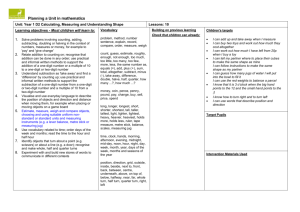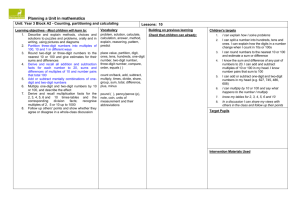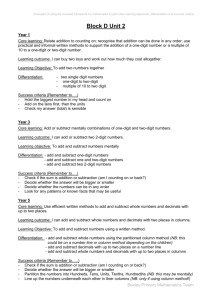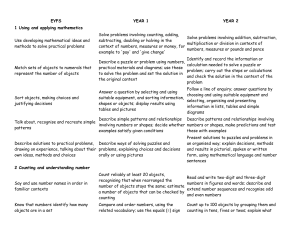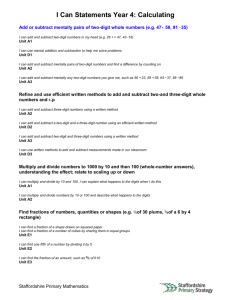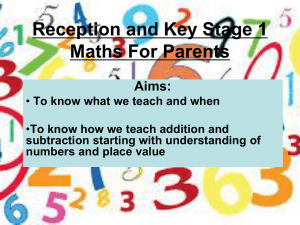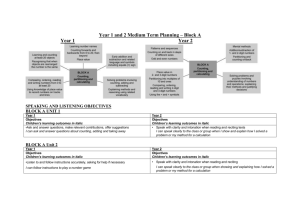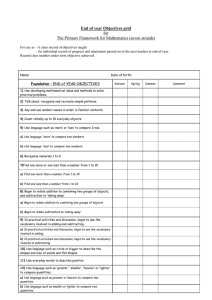Pupil interview questions for Foundation Stage
advertisement
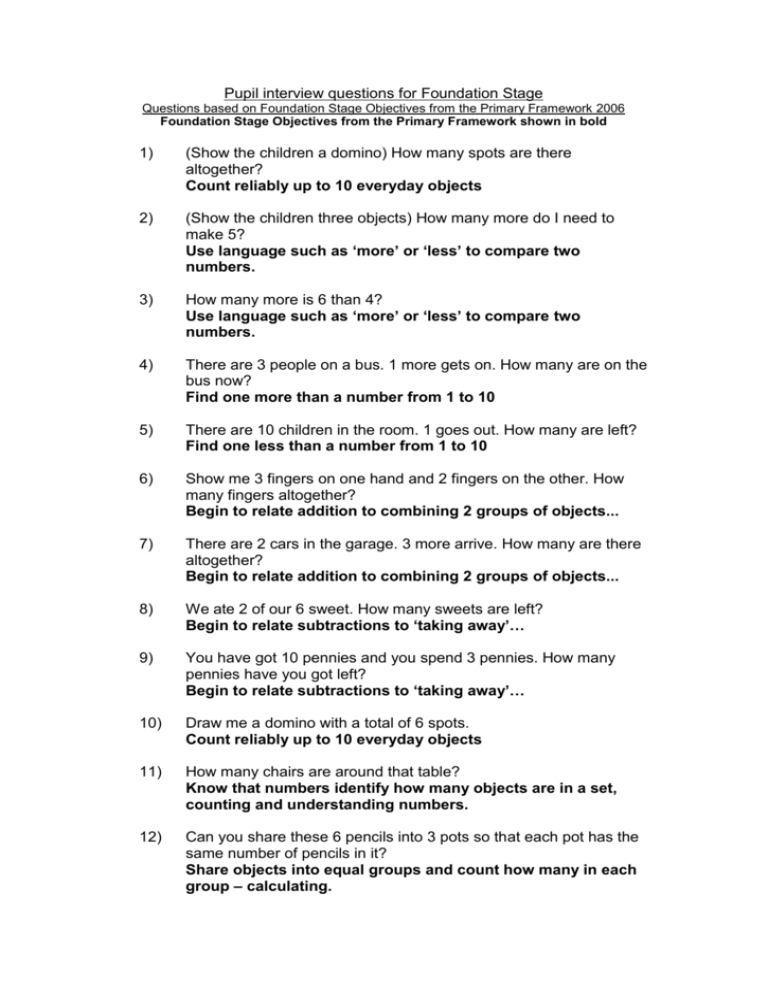
Pupil interview questions for Foundation Stage Questions based on Foundation Stage Objectives from the Primary Framework 2006 Foundation Stage Objectives from the Primary Framework shown in bold 1) (Show the children a domino) How many spots are there altogether? Count reliably up to 10 everyday objects 2) (Show the children three objects) How many more do I need to make 5? Use language such as ‘more’ or ‘less’ to compare two numbers. 3) How many more is 6 than 4? Use language such as ‘more’ or ‘less’ to compare two numbers. 4) There are 3 people on a bus. 1 more gets on. How many are on the bus now? Find one more than a number from 1 to 10 5) There are 10 children in the room. 1 goes out. How many are left? Find one less than a number from 1 to 10 6) Show me 3 fingers on one hand and 2 fingers on the other. How many fingers altogether? Begin to relate addition to combining 2 groups of objects... 7) There are 2 cars in the garage. 3 more arrive. How many are there altogether? Begin to relate addition to combining 2 groups of objects... 8) We ate 2 of our 6 sweet. How many sweets are left? Begin to relate subtractions to ‘taking away’… 9) You have got 10 pennies and you spend 3 pennies. How many pennies have you got left? Begin to relate subtractions to ‘taking away’… 10) Draw me a domino with a total of 6 spots. Count reliably up to 10 everyday objects 11) How many chairs are around that table? Know that numbers identify how many objects are in a set, counting and understanding numbers. 12) Can you share these 6 pencils into 3 pots so that each pot has the same number of pencils in it? Share objects into equal groups and count how many in each group – calculating. Pupil interview questions for Year 1 Questions based on Year One Objectives from the Primary Framework 2006 Year One Objectives from the Primary Framework shown in bold 1) What is 3 add 5? …addition of a one-digit to a one-digit number 2) What is the total of 2 and 7? Use vocabulary related to addition… 3) What is double 4? Recall doubles of all numbers to at lease 10 4) If you have 3 sweets, how many more do you need to make 10 sweets? Use practical and informal methods to support the addition and subtraction of a one-digit number to/from a one or two-digit number 5) What is the difference between 6 and 10? Find a ‘difference’ by counting up. 6) =4+3 Use the equals (=) sign 7) 15 = 10? Use practical and informal methods to support the addition and subtraction of a one-digit number to/from a one or two-digit number 8) Write two numbers that add together to make 9? Use practical and informal written methods to support the addition of a one-digit number to a…one-digit number + Derive and recall…addition facts for totals to at least 5 9) Kelly had 8 grapes in a bowl. She ate some and there were 3 left. How many did she eat? Use practical and informal written methods to support the addition of a one-digit number to a…one-digit number + Derive and recall…addition facts for totals to at least 5 10) A cake has 8 slices. If Dad eats half the cake, how many slices are left? Solve problems involving…halving in the context of numbers… 11) Show the following coins, 5p, 2p and 1p. How much is there altogether? Solve problems involving counting or adding…in the context of money… 12) It’s 5o’clock. What time was it three hours ago? Use vocabulary related to time 13) Barry has 3 pet fish, Gary has 4 pet fish and Harry has 5 fish. How many fish do they have altogether? Solve problems involving counting or adding 14) (Show the children some 1p, 2p, 5p and 10p coins) Lydia paid the shopkeeper 8p. What coins could she have used? Solve problems involving counting and adding…in the context of money. 15) How many toes are there on 3 children’s feet? Solve practical problems that involve combining groups of 2.5 or 10 or sharing into equal groups (i.e. multiplication as repeated addition and division as sharing) Pupil interview questions for Year 2 Questions based on Year Two Objectives from the Primary Framework 2006 Year Two Objectives from the Primary Framework shown in bold 1) Add 10 to 27 Add or subtract mentally a…multiple of 10 to or from any two-digit number 2) Look at these signs > = < Use one of the signs to make this correct 24 18 Order two-digit numbers and position them on a number line use the greater than (>) and less than (<) signs 3) 14 + 3 = 17. Write 3 more number sentences using these numbers. Understand that subtraction is the inverse of addition and vice versa and use this to derive and record related addition and subtraction number sentences 4) 24 subtract 9 Add or subtract a single-digit number from any two-digit number. NB relates to 1999 mental strategy: add / subtract 9 or 11 5) Two ice-creams cost 40p. What does one ice-cream cost? Understand that halving is the inverse of doubling and derive and recall doubles of all numbers to 20, and the corresponding halves 6) What is the sum of 6, 7 and 4? Add or subtract mentally…NB Related to 1999 mental strategy: begin to add three single-digit numbers mentally 7) What is the difference between 22 and 17? Add or subtract mentally + Y1: Find a ‘difference’ by counting up. 8) There are 3 apples in each pack, Mrs Pullen buys 3 packs of apples. How many apples does she buy? Represent repeated addition and arrays as multiplication… 9) 15 / 5 = Derive and recall multiplication facts for the 2, 5, and 10 timestables and the related division facts 10) My cat is 30cm tall. My dog is 25cm taller. How tall is my dog? Solve problems involving addition and subtraction… in context of measures i.e. in ‘real life’ context 11) Look at this number sentence: 20 = + . What could the two missing numbers be? Write 4 different ways of completing the number sentence. Derive and recall…all pairs with totals to 20. NB Relates to 1999 objective: recognise the use of a symbol such as to stand for an unknown number. 12) 64 - 58 = Use practical and informal written methods to add and subtract two-digit numbers. NB Relates to 1999 objective: ding a small difference by counting up from the smaller to the larger number. 13) Put in the missing signs to make this number sentence correct: 10 2 5 Use the symbols +, -, x, / and = to record and interpret number sentences involving all four operations. 14) I got on the bus at 9:30. The journey took half an hour. What time did I get off the bus? Use units of time (seconds, minutes, hours, days) and know the relationships between them + Solve problems involving addition and subtraction…in context of numbers i.e. in ‘real life’ context 15) Patrick bought three chocolate bars at 15p each. How much change from 50p did he get? Solve problems involving addition, subtraction, multiplication or division in contexts of…pounds and pence
